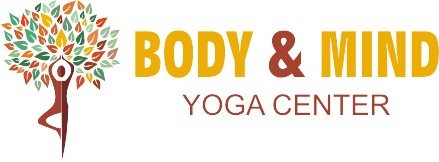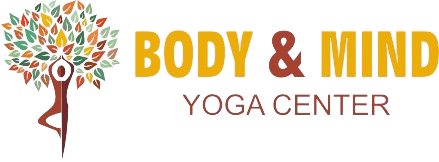Bringing a new life into the world is a beautiful yet physically and emotionally demanding journey. After childbirth, your body undergoes significant changes, and recovery is just as important as the pregnancy itself. Postnatal yoga offers a gentle yet powerful way to heal, rebuild strength, and restore balance. Whether you’ve had a natural delivery or a C-section, incorporating yoga into your postpartum routine can help alleviate back pain, strengthen your core, and improve overall well-being.
What Are Postnatal Yoga Poses (Asanas)?
Postnatal yoga is a specialized practice designed to help new mothers recover physically, mentally, and emotionally after childbirth. It focuses on strengthening the core, improving flexibility, and promoting relaxation, all of which are essential for postpartum recovery. Whether you’ve had a natural delivery or a C-section, practicing yoga can help restore your body’s strength and balance while also relieving stress and fatigue.
Benefits of Postnatal Yoga:
- Core Strengthening: Helps rebuild abdominal muscles weakened during pregnancy.
- Pelvic Floor Recovery: Strengthens pelvic muscles to prevent postpartum complications.
- Stress and Anxiety Reduction: Supports mental well-being and helps manage postpartum depression.
- Improved Flexibility and Posture: Reduces back pain and improves spinal alignment.
- Boosts Energy Levels: Helps new mothers regain stamina and feel refreshed.
Postnatal Yoga Poses: The Best Way to Heal Your Body After Pregnancy
Chaturanga Dandasana (Plank Pose)
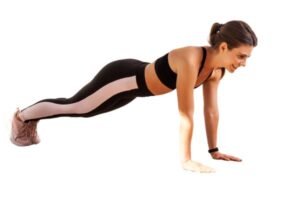
This pose is excellent for rebuilding core strength, improving posture, and enhancing overall body stability. It engages multiple muscle groups, making it a comprehensive full-body workout.
How to Do It:
- Start by lying face down on the floor with your palms placed under your shoulders.
- Press into your palms and lift your body off the ground, coming into a straight-arm plank position.
- Keep your core engaged, ensuring your body forms a straight line from head to heels.
- Hold this position for 15-30 seconds while breathing deeply.
- Slowly lower yourself back down and relax before repeating.
Benefits:
The Plank Pose strengthens the abdominal muscles, lower back, and shoulders, improving posture and endurance. It also enhances core stability, which is crucial for postpartum recovery, and helps reduce lower back pain caused by carrying and nursing the baby.
Bhujangasana (Cobra Pose)
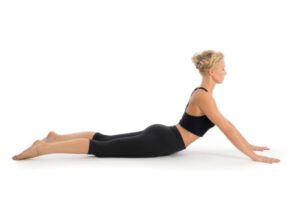
This gentle backbend is particularly beneficial for relieving postpartum back pain, stretching the abdominal muscles, and improving spinal flexibility.
How to Do It:
- Lie flat on your stomach with your legs extended and hands placed under your shoulders.
- Press your palms into the floor and slowly lift your chest while keeping your elbows slightly bent.
- Engage your back muscles and look upward, keeping your shoulders relaxed.
- Hold the pose for 15-20 seconds while breathing deeply.
- Exhale and slowly lower your torso back to the ground, relaxing completely.
Benefits:
Cobra Pose stretches and strengthens the spine, opens up the chest, and improves posture. It helps restore flexibility in the abdominal muscles that were stretched during pregnancy and promotes relaxation by reducing stress and tension in the body.
Tadasana (Mountain Pose)
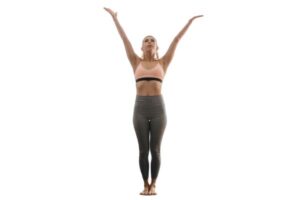
A foundational yoga pose, Tadasana is ideal for improving posture, balance, and body alignment, which are often affected post-pregnancy.
How to Do It:
- Stand tall with your feet hip-width apart and arms resting at your sides.
- Inhale deeply and raise your arms above your head, interlocking your fingers.
- Stretch your entire body upward while keeping your feet grounded.
- Hold the stretch for 20-30 seconds, breathing deeply.
- Exhale and bring your arms back down to your sides, relaxing your body.
Benefits:
Mountain Pose helps in correcting posture, strengthening leg muscles, and improving overall body awareness. It enhances circulation, boosts energy levels, and helps new mothers regain balance and stability in their daily activities.
Trikonasana (Triangle Pose)
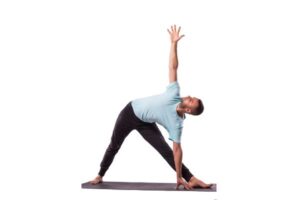
This standing pose strengthens the legs, opens up the hips, and stretches the spine, providing relief from post-pregnancy back pain.
How to Do It:
- Stand with your feet wide apart, keeping your arms extended parallel to the floor.
- Turn your right foot outward at a 90-degree angle and left foot slightly inward.
- Bend your torso to the right, reaching down to touch your right ankle with your right hand while extending your left arm toward the ceiling.
- Keep your legs straight and gaze upward, holding the pose for 15-20 seconds.
- Slowly return to the starting position and repeat on the other side.
Benefits:
Triangle Pose improves flexibility in the spine, strengthens the legs, and helps in digestion. It also enhances balance and stability, which are essential for new mothers adjusting to their postpartum bodies.
Ustrasana (Camel Pose)
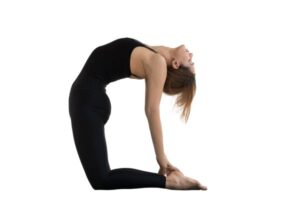
A deep backbend, Ustrasana opens up the chest, strengthens the spine, and improves lung capacity, making it an excellent pose for postpartum recovery.
How to Do It:
- Kneel on the floor with your knees hip-width apart and hands resting on your lower back.
- Slowly arch your back, bringing your hands to your heels while pushing your hips forward.
- Lift your chest and drop your head back, opening up the throat and chest.
- Hold the pose for 15-20 seconds, breathing deeply.
- Slowly return to the starting position and sit back on your heels to relax.
Benefits:
Camel Pose stretches and strengthens the back, opens up the chest, and improves lung capacity. It helps release tension in the shoulders and back, counteracting the strain caused by breastfeeding and carrying the baby. Additionally, it boosts energy levels and improves circulation, helping new mothers feel revitalized.
Precautions And Tips to Practice Postnatal Yoga
- Consult Your Doctor: Always check with your healthcare provider before starting yoga, especially after a C-section.
- Start Slow: Begin with gentle stretches and gradually progress to more intense poses.
- Listen to Your Body: Avoid poses that cause discomfort or pain.
- Focus on Breathing: Deep breathing enhances relaxation and promotes faster recovery.
- Use Support: If needed, use props like yoga blocks or cushions for additional support.
- Stay Hydrated: Drink plenty of water to keep your body hydrated.
- Avoid Overexertion: Don’t rush your progress; allow your body to heal naturally.
Reclaim Your Strength and Well-Being with Postnatal Yoga
Postnatal yoga is a powerful tool for recovery after pregnancy, helping new mothers regain strength, flexibility, and emotional balance. By incorporating yoga poses into your daily routine, you can experience a smoother postpartum transition and a healthier, more energized body. Always practice with patience and self-care, and remember that every recovery journey is unique!
Join us at Body and Mind Yoga Center, where our specialized postnatal and prenatal yoga classes in Dubai provide a nurturing environment for mothers-to-be to connect with their bodies and their growing babies.
